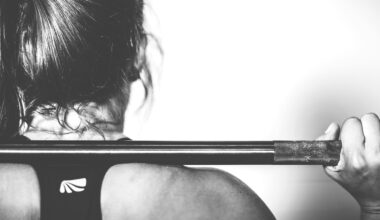Why Core Training is Essential for Weightlifters
Core training has become a vital aspect of a weightlifter’s workout regimen. It plays a crucial role in developing strength, stability, and overall performance. Engaging the core muscle groups improves not only physical appearance but also athletic capabilities. Weightlifting requires a strong and stable foundation, and the core acts as that essential connector. Proper core stability enhances posture, enabling lifters to maintain correct form during lifts like squats, deadlifts, or snatches. Furthermore, a well-developed core helps prevent injuries that may arise from improper lifting techniques. Therefore, incorporating core workouts can enhance a weightlifter’s training outcomes, long-term potential, and body mechanics. Examples of effective core exercises include planks, Russian twists, and medicine ball throws. Aside from strength, core training aids in transferring power efficiently from the lower to the upper body, essential for maximizing performance. Moreover, a strong core encourages better recovery and endurance, assisting athletes with prolonged and intense training sessions. In conclusion, prioritizing core training is indispensable for weightlifters aiming to reach their goals and optimize their performance in the competitive arena.
Developing a strong core is foundational for all weightlifting athletes. This integration of multiple muscle groups allows for efficient lifting and stable body movement. It enhances balance while performing various exercises that require intricate body coordination and stability. The body’s core is comprised of muscles in the abdomen, back, hips, and pelvis, which work together to stabilize the spine. An engaged core can lead to improved form and technique during lifts, which minimizes the risk of injury. Moreover, as many movements in weightlifting include high loads and explosive power, the spine and pelvis are frequently under strain. Thus, reinforcing the core muscles provides crucial support as weights increase. An effective core training program can include both dynamic and static exercises to address the different muscle groups involved. Variations like weighted planks or hanging leg raises can be particularly beneficial for weightlifters. By masterfully engaging these groups, athletes can thus not only lift heavier but can do so with greater control. Core workouts should be balanced with overall strength and conditioning routines to yield the best results in weightlifting and athletic performance.
Benefits of Core Training
The advantages of core training extend beyond just athletic performance. A strong core improves overall functional fitness, thereby enhancing daily activities and quality of life. Individuals involved in weightlifting can experience improved posture and reduced back pain through targeted core exercises. A stable core is essential to controlling body movements, which, in turn, supports everyday activities like lifting heavy objects or performing other sports. With enhanced core strength, lifters will notice increased control over their body movements during weightlifting and general exercises. Importantly, improved core stability contributes to an athlete’s ability to generate force and power during explosive movements necessary for weightlifting. This leads to more efficient lifts and pushing beyond previous limits. Additionally, core training reduces injury risks by reinforcing the muscles surrounding the spine, protecting against damage during heavy lifts. Consequently, athletes can enjoy improved performance longevity and reduced downtime due to injury. Alongside physical advantages, core training can foster mental resilience and focus, which are also components needed for a successful weightlifting journey. In essence, integrating core training can vastly enhance a weightlifter’s overall effectiveness and safety.
Incorporating dynamic exercises into core training can yield significant benefits for weightlifters. Exercises such as the medicine ball throw engage core muscles explosively, mirroring the demands of weightlifting movements. Engaging in these movements helps develop not only strength but also the coordination necessary for successful lifts. Another effective additional exercise is the plank twist, which stabilizes the core while targeting oblique muscles pivotal during twisting motions in lifts. It’s essential to vary core workouts, introducing stability ball exercises or resistance bands to stimulate further area engagement. By alternating between static holds and dynamic movements, athletes can prevent stagnation in their routines. Unique variations of standard core exercises can also enhance muscle engagement. Moreover, training the core dynamically prepares weightlifters for the unpredictable demands of competitive lifting events. As muscles adapt to varying stimuli, athletes will find themselves better equipped during competitions. Furthermore, diversifying the nature of core workouts fosters overall athleticism, as these adaptations translate into greater balance and coordination in various weightlifting scenarios. Ultimately, this approach ensures a comprehensive development of a lifter’s core strength.
Core Training Techniques and Tips
For optimal results from core training, specific techniques and strategies must be employed. One technique involves using tempo variations during exercises—varying the speed at which one performs reps helps challenge the muscles differently. Likewise, utilizing the mind-muscle connection is essential; this means consciously engaging the specific muscle groups throughout each movement, thereby enhancing overall effectiveness. Another effective tactic is utilizing full-body exercises that inherently activate the core. Movements like kettlebell swings or squat presses recruit the core while also building overall strength. To ensure continuous improvements, it’s advised to progressively increase weights or resistance. As athletes become stronger, they should adapt their core training routine to include advanced exercises like the hanging leg raise or single-arm kettlebell windmill. Consistency is equally vital; to witness tangible progress, a structured core training routine should be integrated at least two to three times weekly. Additionally, lifters should prioritize both conditioning and recovery to complement intense core workouts. By doing so, they significantly reduce injury risks while embracing a sustainable approach to personalized fitness. Core training is essential for consistent improvement and injury prevention in weightlifting regimens.
To further optimize core training effectiveness, it’s important to incorporate balancing exercises. Challenges to balance, such as BOSU ball workouts or stability disk exercises, force the core to engage more fully. This stimulation allows for developments in proprioception and body awareness, pivotal for weightlifting. Properly executed, these exercises can lead to gains in overall strength, stability, and coordination. Balance staple exercises, like single-leg squats or reach-ups, can significantly enhance muscle activation across the core and lower body. Additionally, focus on integrating core workouts that can be done with minimal equipment, making them more accessible. Using household items like water jugs or backpacks filled with weight can help maintain versatile core workouts at home. Incorporating lighter weights also allows for refined form, thus preventing injuries while still promoting muscle engagement. Weightlifters will particularly benefit from hybrid exercises combining traditional weightlifting favorites alongside core-centric routines. Examples include deadlifts performed with an unstable surface or front squats paired with oblique twists. This approach not only strengthens the core but elevates overall athletic performance, making such workouts essential for any weightlifter’s goal of success.
Conclusion
In summary, the importance of core training for weightlifters cannot be overstated. It substantially enhances muscular stability, balance, power, and injury prevention. Integrating core workouts into regular training regimens yields immediate benefits in performance, allowing athletes to maximise their weightlifting potential effectively. This focusing on core engagement ensures that lifters can maintain correct posture, generate appropriate force, and minimize the risk of injury during high-volume and high-intensity lifts. Additionally, core training fosters the development of an athlete noting improvements in overall body mechanics. Conditioning the core alongside lifting allows weightlifters to enjoy longer training sessions without discomfort or strain. As such, consistent practice and commitment toward developing core exercises contribute to an impressive strength foundation. As weightlifters implement comprehensive core training strategies, they will notice enhanced confidence during competitions, recognizing their physical accomplishments. To maximize performance and ensure long-term health, emphasis on core strength must be part of a dedicated weightlifting journey. In the end, incorporating effective core training methods can enhance performance, capability, and overall success in weightlifting, leading to impressive results.


